A carnival on steroids: Oral history of the one-of-a-kind Red River Rivalry between Texas and Oklahoma

[video: 13724774]
Take a second to think about the one person or the one thing that you absolutely cannot stand—the guy or the girl who, when you see them or even when you imagine seeing them, it makes your blood boil. Your heart starts to beat a little faster, and you can't really catch your breath because you're just so angry.
If you're from Texas, that person is probably from Oklahoma, and that thing is probably a Sooner. And if you're from Oklahoma, that person is definitely from Texas, and that thing is definitely a Longhorn.
Dewey Selmon, Oklahoma defensive line, 1972–75: You can actually feel your blood racing in your veins. Gosh, that's how tough that game is. You don't play that game the day it's played, you play that game all week prior to it.
Mack Brown, Texas head coach, 1998–2013: Heroes were born in the Oklahoma game. So if you played great in that game, you had a legacy regardless of what else you did in your career. Because you made your name in that game
Kirk Bohls, Austin American-Statesman reporter, 1973–present: I remember coming back to the office, and my phone rings and it's Darrell Royal. He said, "Well you may not believe it, but I'm accusing Oklahoma of spying on our football practices."
Mack Brown: It's not like your home crowd or your away crowd where it's loud for you and quiet for the opponent or whatever. In this game, somebody is screaming every play.
J.C. Watts, Oklahoma quarterback 1976–80: I think it's an incomprehensible pressure that I think that those coaches feel. And I guarantee you, players, we sure felt it.
Barry Switzer, Oklahoma head coach 1973–88: Some redneck from Oklahoma wearing red stands up in the crowd and screams at the top of his lungs in one of these voices that you could hear from three or four sections, "Who are those two assholes with Switzer?!"
Berry Tramel, Oklahoman reporter and columnist, 1991–present: It's like a carnival on the ultimate steroid.
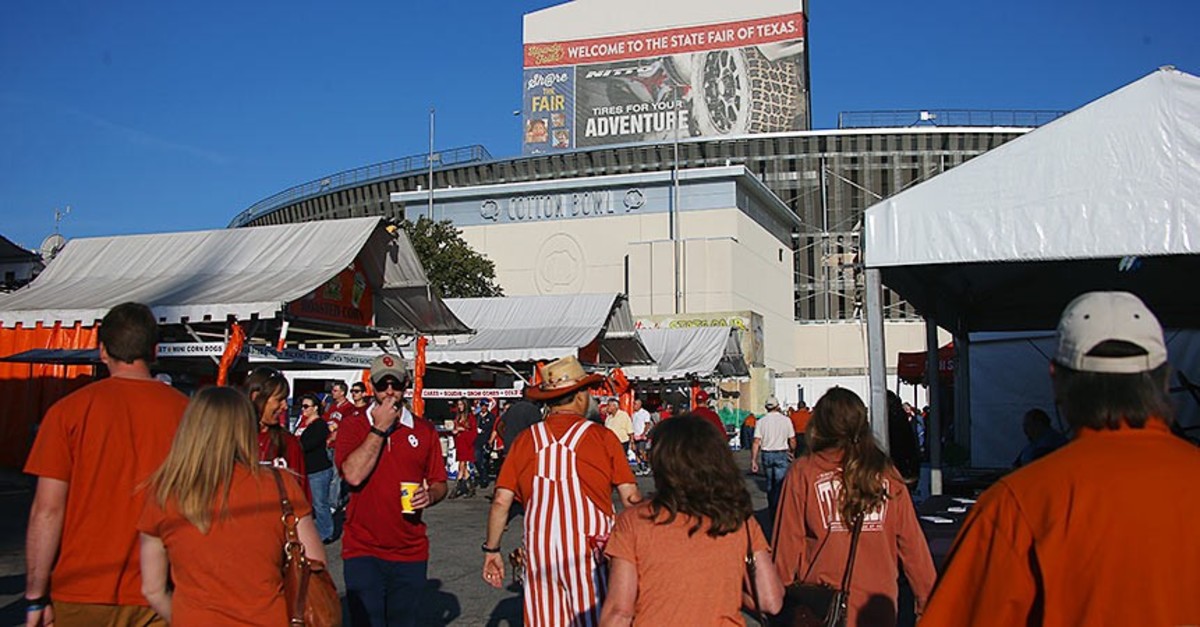
Ronald Martinez/Getty Images
Sports, particularly college sports, are full of bitter rivalries. But only a few have a history that spans decades, with generations of fans and families affected by the final score. Florida-Georgia. North Carolina-Duke. Michigan-Ohio State. Army-Navy.
Those are all important in the college sports landscape. But none of them is played at the Texas State Fair, which gives the Red River Shootout a little something extra—and some would argue, makes it a little better.
It's impossible to detail every game in the rich rivalry or mention every player and coach. But it is possible to pick some highlights—and some low lights—and explain the importance of this game, the weight of the rivalry, and how it means a lot not just to players and coaches, but to fans, too.
Bill Little, Texas football historian: I've always thought of it as a kaleidoscope. You see the colors, you hear the sounds. You can also feel them. You smell the smells of hot dogs and the corny dogs. Everything has an aura about it that makes it so different. But it's more than a game because it brings together all those people on one afternoon, many of them for one single purpose, and another group for a totally different purpose. It was like two warring nations gathering in Dallas, Texas—200 miles from Austin, 200 miles from Norman—and they met together on that one Saturday and they fought their hearts out and then they went away. It's an amazing collection of Americana.
STAPLES: Coaches should follow example of Barry Switzer's "BEAT TEXAS" hat
The Red River Shootout originated in 1900, and—except for a stretch in the 1920s—has been played annually ever since. Overall, Texas leads the series 61-44-5.
Bill Little: In the late '40s, after the war was over, America was looking for something to really get excited about. Those two schools in college football were two of the premier schools at that point. And television began to come into our lives at that point. It might have been a 24-inch, black-and-white TV set, but you could see the game, and you could see a live game. And that was the thing, I think, more than anything that probably began to attract people. In the '50s, as television grew, so did Texas and Oklahoma, and it gave Oklahoma something to really be proud of.
Understanding each state's history is crucial to understanding the importance of the rivalry. Specifically, it's important to know the background of Oklahoma, which has dealt with a state-wide inferiority complex for almost a century.
Berry Tramel: The Dust Bowl hit, and everybody got wiped out by the Dust Bowl: Oklahoma, Arkansas, Kansas, Texas, New Mexico. In the westward migration to California, all the people that went, it didn't matter where you were from, you were called an Okie. If you were from Doomis, Texas, you were called an Okie. If you were from Fort Smith, Arkansas, you were called an Okie. So "Okie" got a really negative connotation. Oklahoma's self-image sort of took a major hit on that.
The Grapes of Wrath, Steinbeck wrote it, and then they made the movie with Henry Fonda. It's actually sort of a noble book. Anybody that reads it would know that the Oklahomans are portrayed as fairly valiant people, but they're also made to look poor and uneducated, which they were.
In 1946, a regent at OU, Lloyd Noble was his name, famously said in a regents' meeting, he pointed out, "We've got an image problem in this state. The war is over, we've got all these guys coming back from the war. What if we went out and hired a coach with access to a lot of these players who will be returning—what if we brought them in and we got good in football?"
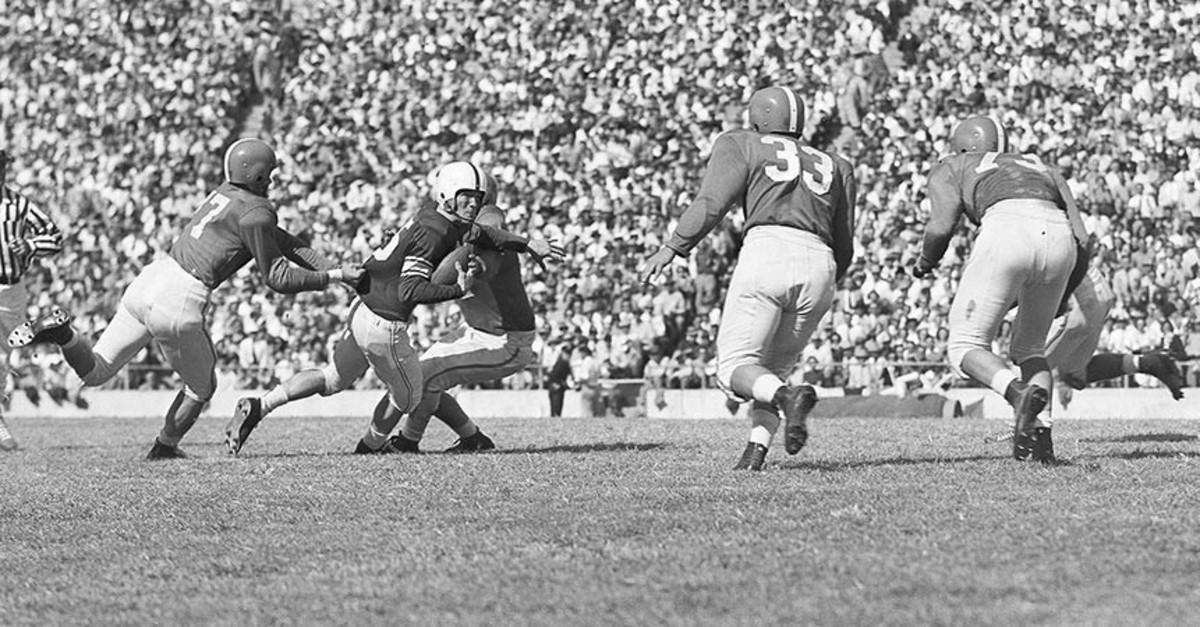
Bob Scott/AP
Oklahoma hired Jim Tatum, who eventually gave way to Bud Wilkinson, and the Sooners started rolling. One of the stars for Oklahoma under Wilkinson was Darrell Royal, a Hollis, Okla., native who played quarterback and defensive back for the Sooners from 1946–49.
Edith Royal, widow of Darrell Royal: Several of the wives would ride in a car to go down to the Cotton Bowl, and that was a lot of fun. We wore our blue jeans on the way and then we'd stop at some fill station and go change into our red clothes, our good clothes, so we could go to the game. That was a fun thing to do.
TEXAS-OKLAHOMA: WATCH THE GAME SATURDAY AT NOON ET ON FS1
The 1947 game, though, wasn't much fun for Edith. But it was memorable.
Edith Royal: There was a big tussle on the field. They had to take a car on the field to get the referee off the field because they were throwing Coke bottles at the referee. They took a car out on the field to rescue that referee and drove him off the field. I had always gone down to meet Darrell on the field and we would go off the field together. And I went down this time, and he said, "You shouldn't be out here on this field!" And he took his helmet off and put it on my head and we raced across the field so we wouldn't get hit by those Coke bottles. It's the last time they ever sold anything in bottles at the Cotton Bowl.
Ten years later, Royal started his tenure as Texas. Over 20 years in Austin, Royal amassed a record of 167-47-5, winning national championships in 1963, '69 and '70. Today, the Longhorns play their home games in Darrell K Royal-Texas Memorial Stadium.
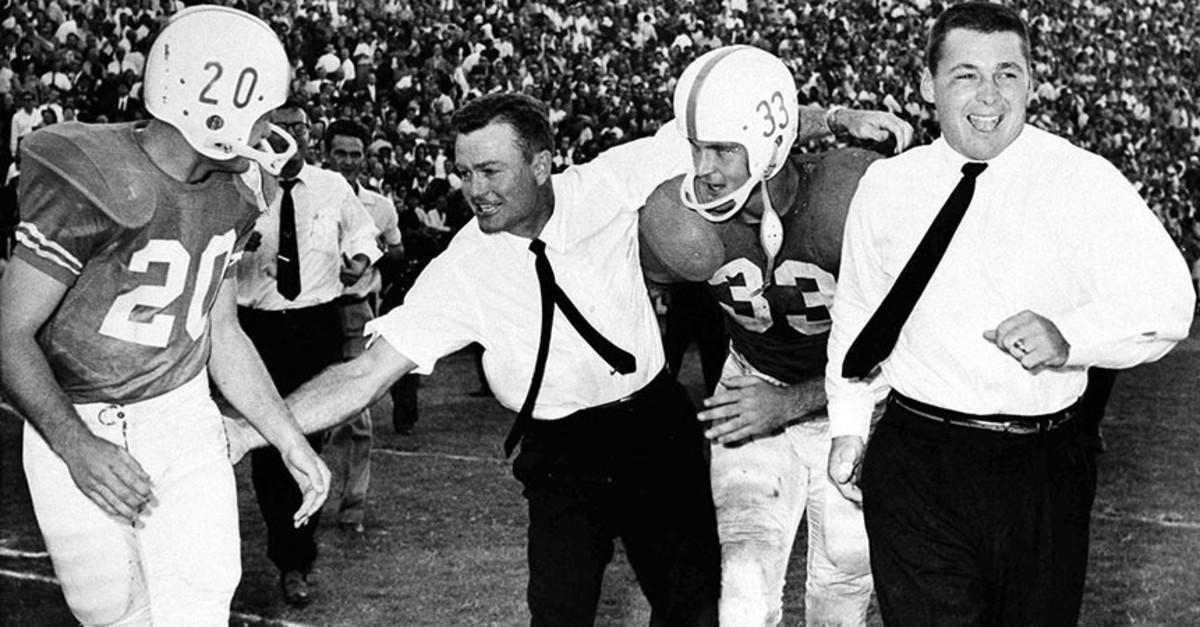
Ferd Kaufman/AP
Royal coached in what is arguably the most important game of the rivalry: the 1963 showdown between No. 2 Texas, and No. 1 Oklahoma, which ultimately catapulted Texas to its first-ever national championship.
Bill Little: Texas had been so close for so long. In 1941 they made a good run at trying to win it, and you've got to realize when you say '41, that sounds like years ago but in that time it was only 22 years before the '63 championship. In '61 they were so close to a national championship and wound up losing to TCU in a game they never should have lost late in the season. So the OU game in '63 was monumental.
To understand the game, it helps to understand the times: In that time there was television, college football was bigger than pro football at the time and every major writer from every major newspaper in the country—that's in the day when there were major newspapers—everybody was there covering that game. Oklahoma came in with a lot of accolades and everyone thought that OU was most likely going to win the football game. And then Texas came with a resounding upset, a 28–7 game. But in those days, 28–7 would be like 56–14 today. It did flip the switch on, and the [national] interest did turn toward Texas.
WEEK 6 PICKS: Who'll win Texas-Oklahoma, Tennessee-Texas A&M, more?
In 1971, Oklahoma snapped a four-game Texas winning streak with a 48–27 win. But to understand the '71 game, first one has to understand 1970, and the schematic change that surrounded it.
Barry Switzer: Texas was the only one running the wishbone. We're having to defend them, and I'm the offensive coordinator and I'm sitting there looking at this film. And I told [former Oklahoma head coach] Chuck Fairbanks, "Chuck, you're wanting to change offenses. This is what we need to do." And he said, "Oh no, we can't copy Texas!" Well hell, everybody copies everybody anyway. What the hell? Just because they're the only one running the wishbone means that they've got a patent on it?
But after "Chuck Chuck!" bumper stickers came out in 1970, I went into Chuck and I said to him, "You see these bumper stickers? Well, if you get your ass fired, they're gonna fire everybody! Let me tell you: We need to go to the wishbone, it's the only chance we've got. We're not going win running this Houston split veer." And thank God he listened to me and we changed to the wishbone the day before we played Texas. I saw that we had a great chance to be a great team.
That day in 1970, Oklahoma was not a great team. The Sooners got smashed, 41–9. Texas, then ranked No. 2 in the country, would go on to win its second consecutive national championship
But in 1971, the wishbone worked to perfection, as Oklahoma won 48–27, the first in a five-game winning streak. Their dominance extended beyond the Cotton Bowl, as the Sooners claimed national championships in '74 and '75.
That winning streak finally came to a halt, or at least a pause, in 1976, when J.C. Watts got on campus in Norman.
J.C. Watts, Oklahoma quarterback, 1976–80: In 1976 I had come here from Eufaula, Okla., and I remember complaining. All freshmen go into a program and think they should be starting. You come out of high school as "Mr. It" and "Mr. Big Shot" and all that stuff, and then you get humbled going to a program and finding yourself seven out of eight quarterbacks. You work your way up to No. 3 and you think you should be playing when you really shouldn't be. I remember I was promoted to backup quarterback my freshman year because our starting quarterback was a guy named Dean Blevins. He got hurt, and Thomas Lott, our backup, he was the starter and I was his backup.
I remember coming down that ramp at the OU-Texas game having been complaining in my mind and in my heart, complaining because I wasn't playing. Coming down that ramp that Saturday, my prayer was "Dear God, don't let anything happen to Thomas Lott. I don't wanna play today!" Because there was just, I mean, the building was everything that coach Switzer had said and more. And I'm thinking, "O.K., maybe I was wrong in complaining all this time. Maybe I'm not so sure I want to play in that."
STAPLES: Texas once again playing for Charlie Strong's job vs. Oklahoma
But 1976 was memorable for another reason: the original Spygate.
Kirk Bohls: You were born in Texas hating the Sooners. I was born in Taylor, Texas, which is about 45 miles from Austin. My dad actually played football at UT. He wasn't a letterman, he was just basically on the team a couple years. He was a high school football star in Taylor. His name is Leon Bohls. His nickname was Leaky because he used to "leak" through the line.
My first memory of OU was basically going to the state fair as one of four boys. My mom and dad always went to the Texas-Oklahoma game and they would just unleash the four of us boys on the state fair for about five hours. We were just wandering around the fair. We used to ride that sky ride that went from one end of the fairgrounds to the other, trying to peek into the stadium to see if we could get a glimpse of the score. We couldn't see hardly anything, but it was the closest thing to being there. We would try to sneak in sometimes in the fourth quarter. Most of my memories of the Texas-OU game was Fletcher corny dogs and all things edible, the new cars they'd trot out, and that sort of thing.
In 1976, Bohls was a 23-year-old reporter who had just been assigned the biggest beat at the Austin American-Statesman: He was going to cover Texas football and legendary coach Darrell Royal.
Kirk Bohls: Back then, you went to every football practice, you never missed a practice. I remember coming back to the office about 6 o'clock on a Thursday, and my phone rings and it's Darrell Royal, who didn't make a habit of calling young cub reporters, trust me. And he said he had a story for me. And I said, "O.K., I'm all ears. What's the story?" He said, "Well you may not believe it, but I'm accusing Oklahoma of spying on our football practices."
We talked for about an hour and he told me he'd been tipped off to a fellow by the name of Lonny Williams out of Rockwall, Texas, had been spying on Texas practices, disguised as a painter, hiding in air conditioning ducts, and all that sort of thing. And Darrell wanted to go public with it.
One of the ways we pinned it down was we tracked down Larry Lacewell, who was Barry Switzer's assistant coach. We were able to find out from his wife that he was on a recruiting trip in Tulsa, staying at a Holiday Inn. We called the Holiday Inn, and tried to find him. He wasn't there. So we finally put two and two together: Where else would a football coach be on a Thursday night? So we called the Holiday Inn back and asked for the bar and we were able to find Larry Lacewell in the bar. We had talked to the Holiday Inn operator when we were trying to track down Larry Lacewell. We probably fudged a little bit. We said, "We're trying to get together a group of people and all trying to find Larry and we wondered, has Lonny Williams called?" And they said yes he had called about five minutes earlier. So we knew they had a relationship.
So we talked to Larry, and he said basically that [Lonny] was a friend of his but denied any accusations of spying. And Darrell had also told us that he would offer $10,000 to Barry Switzer's favorite charity if he would take and pass and lie detector saying he had no knowledge of Oklahoma spying on Texas football practices. And of course Barry Switzer never took him up on the offer. Larry Lacewell once said, "Make it $300,000 and you've got a deal!" And Darrell, when he heard that quote said, "Well I guess we've established the price of what it's going to take to get them out of coaching."
That story ran the next morning, and an AP reporter, a grizzled veteran, he had gone over to talk to Darrell about our spying story. At the end of the interview, Darrell, who was an Oklahoma legend, an All-American quarterback and punter for the Sooners, made the comment, off-hand, thinking the interview was over, calling the Sooners "a bunch of sorry bastards." And the reporter wrote that in his follow story. And that just set off a scene in the Cotton Bowl unlike any other I'd ever seen.
Barry Switzer: I'll never forget it. Gerald Ford happened to be at that game. Darrell comes out of his locker room, I come out of my locker room, and we're to walk down with Gerald Ford to do the coin flip. As we got down to the bottom of the ramp, neither one of us had said a word or spoken to each other. Gerald Ford is trying to figure out, "What in the hell is going on here? Maybe these guys already have their game faces on and this is what coaches are like before kickoff of big games."
Well, as we got down to the bottom of the ramp and walk down the field, some redneck from Oklahoma wearing red stands up in the crowd and screams at the top of his lungs in one of these voices that you could hear from three or four sections, he stands up and yells, "Who are those two assholes with Switzer?!" And I'm telling you, the crowd is dying laughing, and I felt 2 inches tall. I'm embarrassed.
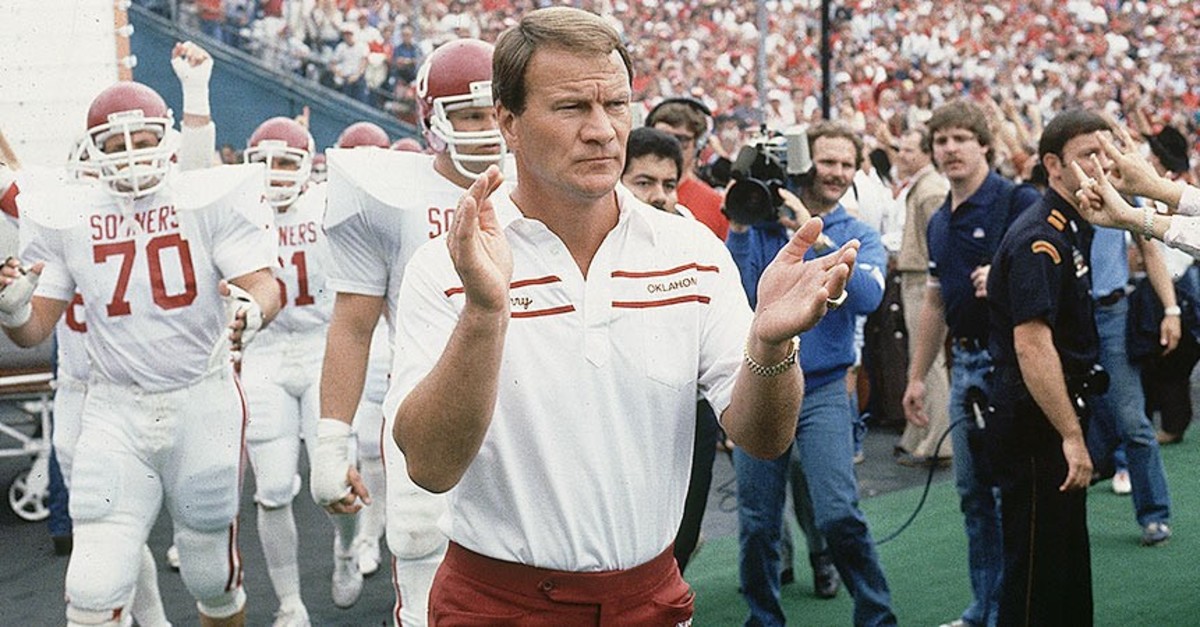
Andy Hayt
Switzer denies that his staff ever spied on Texas.
Barry Switzer: Let me tell you exactly what happened. People don't understand this: When I defended my coaching staff in 1976 and said my coaching staff never spied on Texas, well that was true. I was telling the truth. It's semantics we're talking about here because when the spy incident happened, I wasn't head coach. It happened in '72 when Chuck Fairbanks was the head coach and Lacewell was the defensive coordinator. And he had his buddy Lonnie Williams go watch practice. He went out there and watched them and said they shifted into a quick-kick. And sure enough, I wasn't aware we working on this, I wasn't aware Lonnie Williams had talked to Lacewell at the time, but later on we did.
Then Lonnie Williams kept running his mouth and he told everybody. Finally word got back to assistant coaches at Texas, and got to Darrell. But it took a long time for Darrell to ever come out and accuse us of cheating and spying on them. Well that spying incident happened in '72. It didn't happen in '76 when I was head coach! It was all semantics. I was telling the truth, it wasn't my staff. When I did become head coach I told every one of my staff, "You son of a b****, I'll fire you guys if you spy on Texas. We're not gonna do that crap! We've got good players, we'll beat their ass without having to do that!"
In the end, the cheating and spying and name calling turned out to be all for nothing.
Barry Switzer: We went out and had the coin flip and ended up in a damn tie that day because we muffed a damn extra point.
Like most rivalries, the Red River Shootout has had its share of controversies, with arguably the biggest one coming in 1984 in pouring rain. In the final seconds, with Oklahoma leading 15–12, Oklahoma's Keith Stansbury appeared to pick off Texas quarterback Todd Dodge. As multiple people recounted, Stansbury snatched the ball out of the air then fell on the ground, sliding out of bounds after the catch because the field was so slick. But officials ruled the pass incomplete, and Texas kicked a field goal to end in a 15–15 tie.
Barry Switzer: So we line up, they throw into the end zone and Andre Johnson, our cornerback, reaches over the receiver and taps the ball out of his hands. Just a great defensive play. Keith Stansbury, our strong safety, catches it plainly, wraps it up, hits that wet turf and slides three yards out of bounds. Just slides across the end zone all the way, in bounds in the end zone, all the way out. And there's a guy named Butch Clark [an official] is standing there looking right at him and waves it out of bounds. And it's clearly caught three yards in bounds and everybody in the stands could see it. They know, Texas knows it, you can look at film of it today and it's so obvious. How in the world you call that out of bounds? We would have taken the ball on the 20-yard line and downed it, and the game would have been over and I'd have had another victory over Texas. But it didn't happen and we got screwed out of that one. When you get screwed out of one, it really upsets you because they're hard to win.
THAMEL: Texas 'very close' to firing Charlie Strong at season's end
One person who never got robbed? Peter Gardere, the former Texas quarterback who went 4–0 against the Sooners. A third generation Longhorns player, Gardere is the only quarterback from either side to go undefeated against his Red River Rival in the history of the series.
Peter Gardere, Texas quarterback, 1989–92: Of course the freshman year is my favorite. Scoring that last touchdown to Johnny Walker. And then also '92, beating them. They expected it to be a tight game, but we really pulled through and kind of had the game in hand pretty much the whole time. And then at the end of the game all the OU fans were saying, "Graduate! Graduate!" because they had gone four years of watching us beat them. So they were ready to see me go. The seniors that I came in with, blood sweat and tears, to have them not lose an OU game, too. It's unfortunate I get all the credit, but the defense really kept us in all those games and won three of the four for sure.
Like most rivalries, the Red River Shootout is often highly emotional.
Charlie Strong, Texas coach, 2014–present: You've got to ride the emotion. I always tell them that what we always have to think is momentum is always on our side—because they're going to catch a wave where they're going to ride it, and then we're going to catch a wave where we're going to ride it. And then it all settles down. And once everything settles down, then it's time to just lock in. But it's going to be an emotional wave.
But sometimes, that emotion is not just because of what's happening on the field. In 1998, SMU lost a cherished member of its family when legendary Mustangs running back Doak Walker died in September from injuries sustained during a skiing accident. A couple weeks later, Texas running back Ricky Williams, who had grown close to Walker, changed his jersey number right before the Red River game to honor Walker. It was also Mack Brown's first game as Texas head coach.
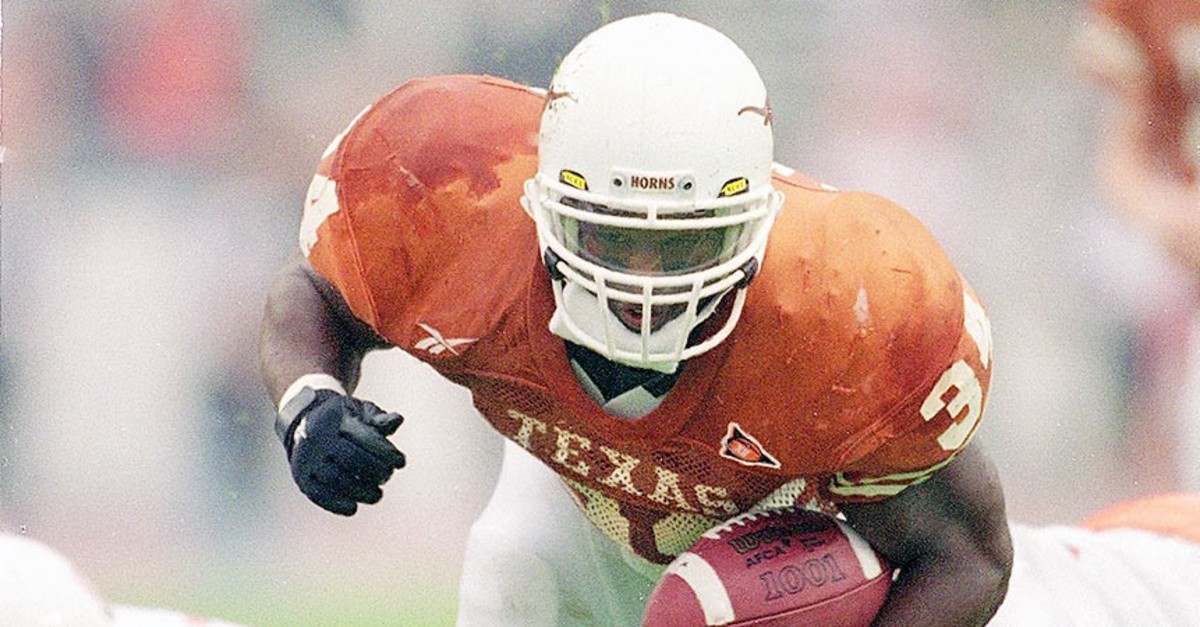
Peter Read Miller
Mack Brown: Ricky came to us, he had Doak's picture up above his locker and we had a rule at that time you couldn't have anything on your locker, but we gave him permission to put Doak's picture above his locker. And then we had to petition the NCAA to have a number change midseason. And they allowed us to do that. And then the thing that I remember most about the game, there were two things that really stood out: Ricky had a 37-yard run for a touchdown, which was Doak's number that he was wearing. And at the end of the score, he looked up and pointed to heaven. And then in the dressing room after the game, coach Royal was in there and we brought the whole Doak Walker family in. And Ricky and coach Royal awarded them the game ball. And I think he even gave them the jersey. That was pretty heavy.
Oklahoma fans, meanwhile, remember a different Williams for a very different, very fun, reason. In 2001, Sooners safety Roy Williams dove over the Texas offensive line, tipping the pass as it left Texas quarterback Chris Simms's hand, which led to an interception and touchdown that helped Oklahoma lock up a 14–3 win. It is often called "The Superman Play" because of how Williams resembled the superhero as he flew over the line, arms outstretched.
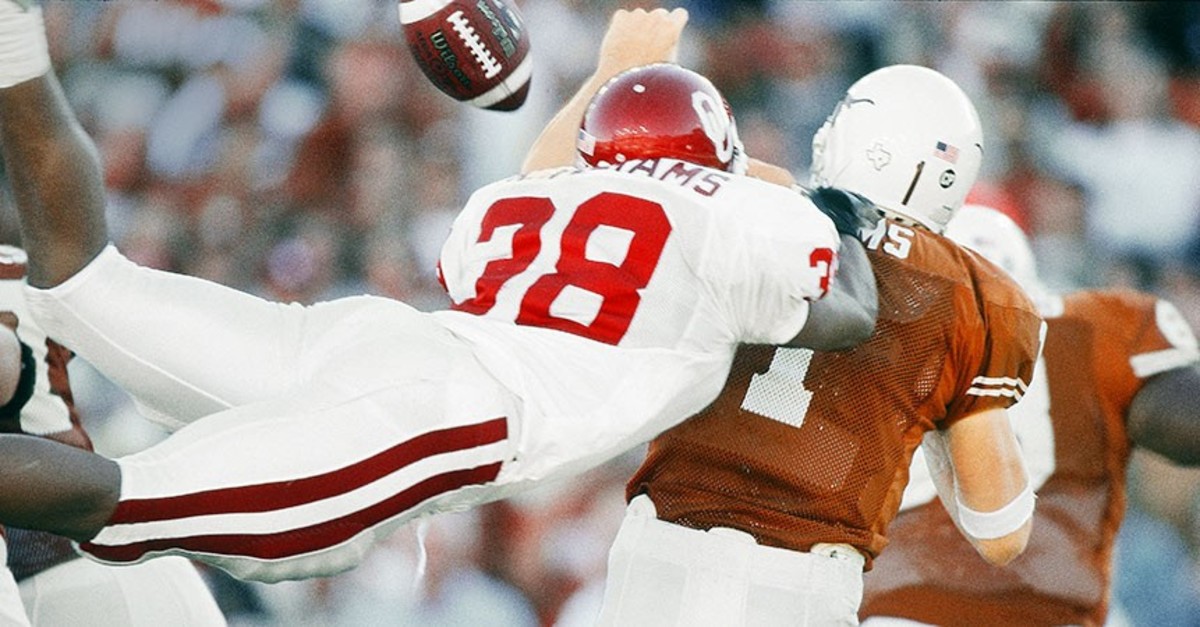
John Biever
Bob Stoops, Oklahoma coach, 1999–present: Funny thing about that play, I didn't see it happen because I was watching our defensive end. We were zone blitzing, and I spent the timeout or the time ahead of the play really trying to make sure that the D-end really got underneath their Roy Williams because I knew they'd want to go to him. So when the ball is snapped, all I'm watching is the D-end get underneath Roy Williams and get in position. And then everyone goes crazy, and I don't know what happened. So I'm running around asking everybody "What happened?," But I did have a good feeling immediately in that I saw all our guys excited, so I figured something good happened for us.
Any of the ones we've won [are my favorite]. Guess it would probably be the 2000. Just because I got here in '99 and we lost the first one. Pretty good game. And then, in 2000, we had such a big win. And we were playing so well. And so, I'd probably pick that one, and that kind of jumpstarted us. And then we went on to win the national championship that year.
Texas had its own version of that—using the Red River game to jumpstart a championship season—in 2005 with Vince Young.
Mack Brown: We played Ohio State, who was really, really good—they were a top-five team—in Columbus. And we beat Ohio State 25–22. But we had not beaten Oklahoma. These guys could not beat them, they had a streak against them. So we knew that we couldn't start talking about anything else until we beat Oklahoma. And then the guys thumped them really well in the ball game.
The game is so important. And the media and the fans either build you up so much when you win that game and think you're for real, or they beat you down so much. I think that's why the game goes in streaks. Because when you get beat in that game, the winner is reinforced to a very high level, and the losers are so criticized that they do feel pressure.
And it's not just pressure from fans and coaches and the media, it's within families, too. Especially if you have a family member who played at Texas or Oklahoma, and you're carrying on their legacy.
Dewey Selmon: On the farm did we have a really big dislike for Texas? No, but the two years that Lucious had played prior to I getting there, we definitely wanted OU to win the football game...
With brothers Dewey, Lee Roy and Lucious, the Selmons formed what is widely considered the best defensive line in Oklahoma history when they started together in 1973. With a Selmon brother on the roster, the Sooners were virtually unstoppable, compiling a 54-3-1 record, earning four consecutive Big 8 titles, posting back-to-back undefeated seasons and winning national championships in 1974 and '75. During Oklahoma home games, Sooners fans would hold up signs thanking Mrs. Selmon, the brothers' mom, for her contribution to Oklahoma football.
Dewey Selmon: Just watching it, we started to become mesmerized and indoctrinated into the idea that OU is supposed to win the OU-Texas rivalry. So that did become a part of our psyche.
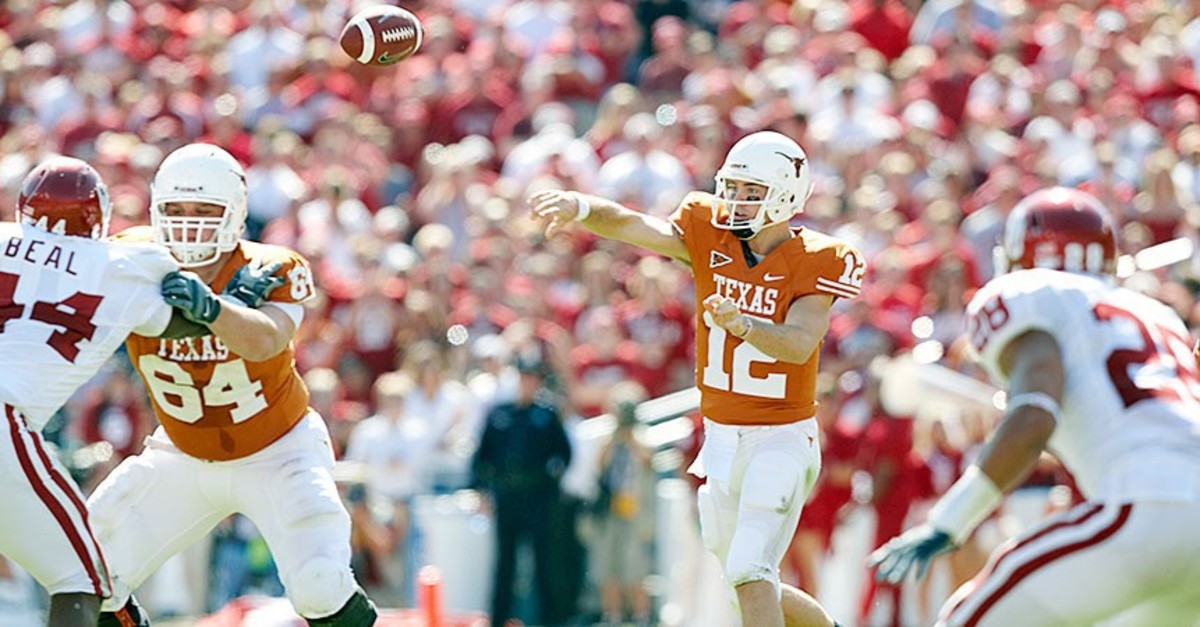
Damien Strohmeyer
Colt McCoy, Texas quarterback, 2006–09: I remember calling [younger brother Case] after he beat OU, I don't remember exactly the year it was. It was maybe his last year in school. And just saying like, "Man, I'm so proud of you. Have fun with that." It's one of those things that, until you do it or until you get to be a part of that game, you just don't appreciate it.
There's so many memories. It's hard for me to pin down one. But I remember winning that game as a freshman and thinking like, "Man, this is unbelievable. I'm so happy." I had this sense of pride about Texas and about our school, and really thinking, "Man, I get to play in this game three more times." I had that game circled as soon as the schedule came out.
Sometimes, even years later, the rivalry gets heated in locker rooms far away from the Cotton Bowl.
Johnnie Johnson, Texas defensive back, 1976–79: I can remember even playing in the NFL against guys who went to Oklahoma, and as we talked, we were teammates in the NFL, but we'd talk about the game and that week we, as professional teammates, you almost have to sit in a different room that week. It's just so intense.
Sometimes it's even more intense for the next generation.
Johnnie Johnson: The thing I think I'll forever remember about my sons [Kirk and Collin, current Texas players] and the recruiting process—because they were heavily recruited—we had an academic counseling meeting. Obviously, they were preparing for college and they had decided that they were gonna go to the same school. And the high school academic counselor being from San Jose, Calif., who's a great guy, and he just started mentioning some schools. And he mentioned Oklahoma, and the boys looked at each other like "Are you kidding me?" I'll never forget that look. And I realized, "Oh O.K., they've got a little UT in them just from growing up in the Johnson household.
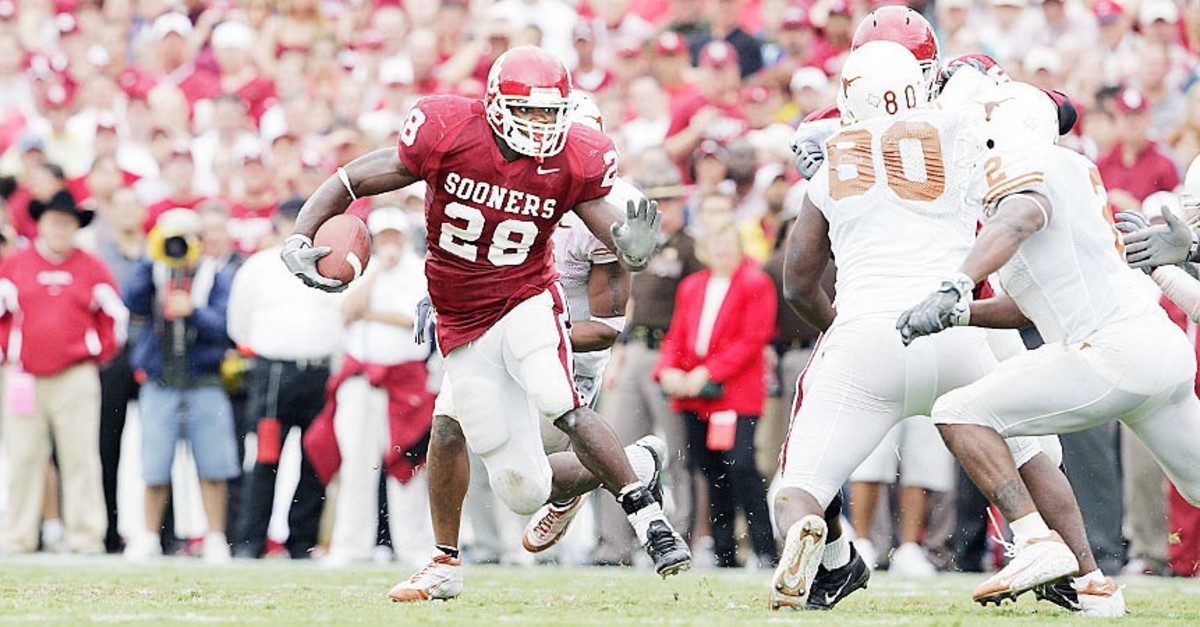
Bob Rosato
Family ties go a long way in this rivalry. But sometimes, even blood isn't enough. Consider the case of Adrian Peterson, one of the best running backs in the history of Oklahoma's program and in the modern era of college football overall. Peterson, a Palestine, Texas, native, who had an uncle that played at Texas, always figured he'd suit up for the Longhorns in college. Then he had a very memorable conversation with Mack Brown.
Adrian Peterson, Oklahoma running back, 2004–06: My uncle, he played at the University of Texas in '97, '98, four years he played there, played with Ricky Williams and all those guys. I used to go up to the spring games and stuff when I was coming up. I was such a big Texas fan. Everything was UT. I remember standing up top of [the ramp], where the players come out, waiting for my uncle to come out, looking out at the stadium, at the scoreboard and telling myself then, "I'll be back here to play at the University of Texas." I remember speaking those words.
Once I got to my junior year, and I became the No. 1 player in the nation my junior and senior year, my first official offer was from University of Oklahoma. Texas A&M was my second offer and then Texas came in and offered me. I'm still a little salty, but I'm UT all the way in my mind.
I remember going up and talking to Mack Brown and I asked him the same thing I asked all the other coaches I met with: "Hey coach, I grew up here in Texas, grew up watching the Longhorns, my uncle played here. I remember sitting out here and telling myself that hey, one day I'll come here and play and now I have that opportunity. I just want to ask you one thing: If I come here, will I have the opportunity to compete for the starting running back position?" Mack Brown told me, "Well, Adrian, here's the thing: Cedric Benson, he's coming back for his senior year. So we're going to be loyal to him and let him finish out because he's coming back. Once he's gone, then, yeah, we'll open the doors and let you compete for it." I said, "O.K.," and I remember leaving that meeting and I remember X-ing Texas out, which I never thought I'd do.
I often think, he could have lied to me and I would have gone to Texas! I'm sure he thinks about it. He thought about—I'm sure he did—especially after the first game, when I went for 225 [yards] on them.
All these years later, Peterson still thinks regularly about that conversation with Mack Brown. In a rivalry you don't forget slights—especially a rivalry as bitter and as historic as this one.
